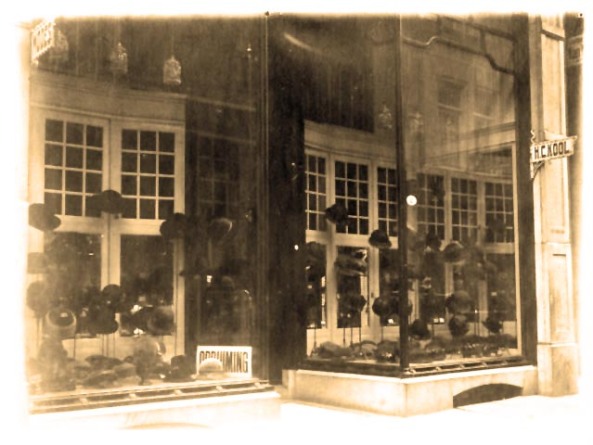
A photograph of the H.C. Kool hat shop windows in Groningen, Netherlands, taken about 1925. (Anje Belmon/Contributed)
I have heard about my mom’s great-grandparents running a hat shop in Holland for just about as long as I can remember. On the ground floor was the hat shop itself; on the second floor, the factory; and on the third floor, the family apartment. Recently, I’ve had a little more time to look into it and finally put up this blog post, which I’ve been meaning to do for about six months or so. So here goes…
The shop was named simply for my great-great-grandfather and great-great grandmother: H.C. Kool (Halbo Christina Kool).
Halbo was born on Feb. 11, 1873, in Veendam, Groningen, Netherlands.
Halbo was 26 when he married my great-great-grandmother Christina Kolle, also 26, on Feb. 23, 1899 in Groningen. On their wedding certificate, he is listed as a merchant, which I believe allowed him to travel and procure materials. While Christina did not list an occupation, she did have a reputation as an excellent seamstress.
In March of that year, the advertisement below was printed to announce the shop’s opening. From what I can tell via Google Translate, the writing essentially says he has opened a shop for women’s and children’s hats in mid-March with many French styles.
He also writes that it is in the “Oude Kijk in ‘t Jatstraat” — a street that cousin Anje says exists and has existed since 1739 — following that with the abbreviation “H 178,” which I am inclined to think was the address, or House 178 Anje suggested.
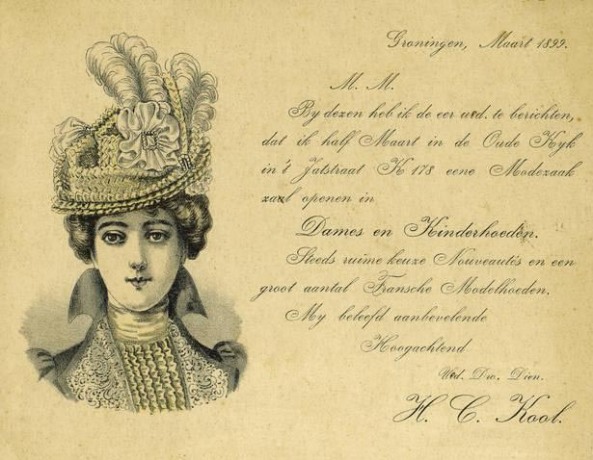
An advertisement for the H.C. Kool hat shop in Groningen, Netherlands, dated March, 1899. (Carolyn Kool/Contributed)
The next year, when their first son (Cornelis “Cees” Kool, July 6, 1900) was born, Halbo was listed as a “reiziger,” or a “traveler” in English, on the birth certificate. I suppose working as a traveler could be similar to working as a merchant, but I do not know why the wording changed. Because the store — with the three levels — was located at Stoeldraaierstraat 2 later (see the address on the brochure below), I wonder if the first store did not thrive at the first location, a second was at Stoeldraaierstraat 2 and in the meantime Halbo kept things running by securing materials in his travels? Or possibly it just moved and there’s no real distinction to be made between the Dutch words for merchant and traveler.
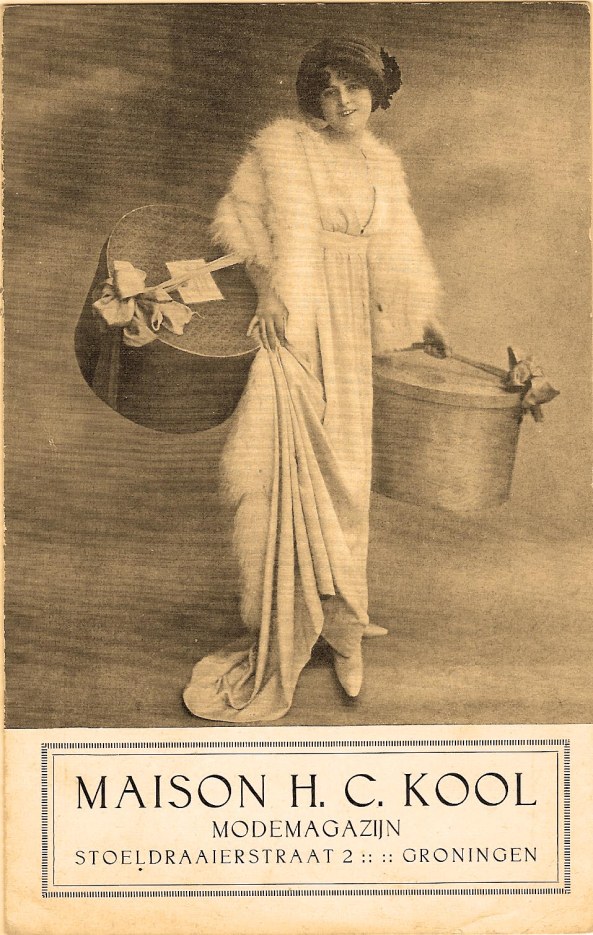
The cover of the hat shop brochure, or so-called “modemagazijn” or “fashion magazine,” for H.C. Kool in Groningen, Netherlands. Likely printed between 1905-1920. (Anje Belmon/Contributed)
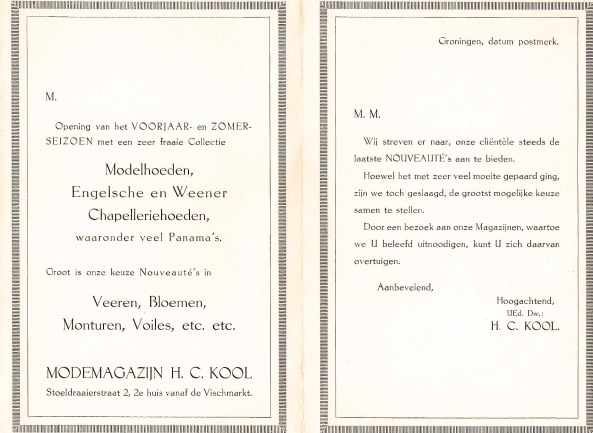
The inside of the hat shop brochure, or so-called fashion magazine, for H.C. Kool in Groningen, Netherlands. (Anje Belmon/Contributed)
The Kools on Jan. 25, 1907, had a second son, whom they named Halbo Christiaan, making it a family of four in the apartment above the workshop and store.
Christina ran the shop and trained the women who worked there, but now she had two sons to raise as well, according to cousin Anje (a descendant of Halbo Christiaan) and her aunt Anneke, who also noted that Christina traveled to Paris and Brussels to buy stock for the stock — so it wasn’t just Halbo securing materials.
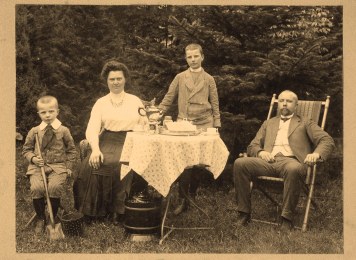
The Kool family, from left: Halbo Christiaan Kool, Christina Kolle, Cornelis Kool, and Halbo Kool. (Anje Belmon/Contributed)

The Kool family apartment above the H.C. Kool hat shop at Stoeldraaierstraat 2 in Groningen, Netherlands. (Anje Belmon/Contributed)
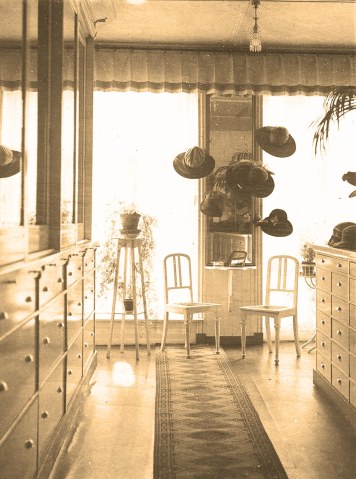
A photograph of the inside of the H.C. Kool hat shop in Groningen, Netherlands. (Anje Belmon/Contributed)
“When Halbo and Christina where married 25 years, in 1924, their employees made a small picture book with photos of the shop and the house to congratulate them,” cousin Anje wrote in an email, which also noted that there was a basement floor of the building that acted as the kitchen. The two images to the left are from the anniversary present.
Anje estimates Halbo and Christina purchased a home in Haren, a village near Groningen, between 1920-1935. Around 1934, Halbo and Christina were renting out the shop and enjoying their free time, vacationing at “Noordwijk bij Zee” a small popular seaside resort in province South-Holland, according to cousin Anje.
Halbo eventually passed away on October 4, 1942, after which Christina went to live with Halbo’s brother, Germ.
Germ was “A former ship’s captain, who had a housekeeper, so Christina couldn’t even cook herself,” according to an email from Anje. “I can’t imagine how this must have been for this strong independent woman. Eventually in 1956, she was “allowed” to go back to her house in Haren. But not before her two children, Cornelis and Halbo Christiaan had discussed this thoroughly and given their permission.
“Cornelis was afraid that something could happen to her in that big house, my grandfather Halbo Christiaan said ‘just let her go, if she wants to.'”
The shop was leveled on April 15, 1945, less than a month before WWII ended. An “exploding ammunition car destroyed some streets in the center of Groningen, including the hat shop,” Anje wrote. Christina was given financial compensation by the council for the loss.
Eventually, Christina passed away — in her own house mind you — on November 21, 1957. She was buried next to Halbo and the grave still exists to this day.



